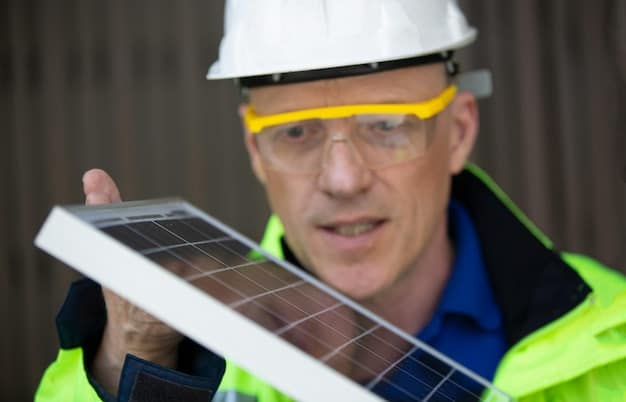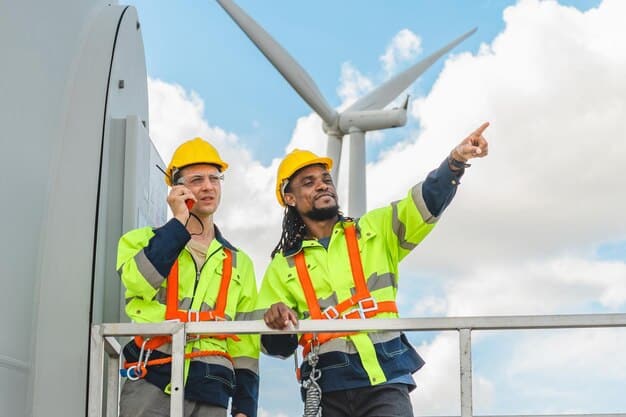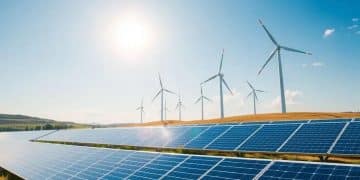White House’s $50 Billion Renewable Energy Infrastructure Plan: Details & Timeline

The White House has announced a comprehensive $50 billion infrastructure plan aimed at bolstering renewable energy sources across the United States, focusing on modernizing the power grid, expanding clean energy technologies, and creating jobs in the green sector.
The Biden administration has recently unveiled a groundbreaking $50 billion infrastructure plan, signaling a major push towards renewable energy. This initiative promises to transform the nation’s energy landscape. The White House Unveils $50 Billion Infrastructure Plan Focused on Renewable Energy – Details and Timeline are now available, marking a significant step towards a greener future.
White House Greenlights $50 Billion for Renewable Energy
The United States is on the cusp of a significant energy revolution, spearheaded by the White House’s ambitious $50 billion infrastructure plan. This initiative is poised to inject substantial investment into renewable energy projects nationwide, promising a cleaner environment and a more sustainable economy. The plan addresses pressing needs in energy infrastructure and aims to accelerate the transition to green energy sources, setting a new course for the nation’s energy future.
The scope of the plan is extensive, covering everything from modernizing the power grid to supporting the development of innovative clean energy technologies. It is designed to not only reduce the nation’s carbon footprint but also to create numerous high-paying jobs in the burgeoning green sector. By focusing on long-term sustainability and technological advancement, the White House hopes to position the U.S. as a global leader in renewable energy.
Key Components of the Renewable Energy Initiative
This comprehensive plan encompasses multiple critical areas, ensuring a broad and effective approach to renewable energy development. Each component is designed to work synergistically, maximizing the impact of the investment and fostering a resilient and sustainable energy infrastructure for the future.
Modernizing the Power Grid
A significant portion of the $50 billion is earmarked for modernizing the nation’s aging power grid. This upgrade is essential for efficiently transmitting renewable energy from sources like solar and wind farms to homes and businesses. Modernization efforts include implementing smart grid technologies that can better manage energy flow and reduce transmission losses. The investment will also enhance the grid’s resilience to extreme weather events, ensuring a more reliable energy supply for all Americans.
Expanding Clean Energy Technologies
Another key focus is on expanding the deployment of clean energy technologies. This includes investing in the research, development, and deployment of solar, wind, and hydroelectric power. The plan also supports emerging technologies like energy storage solutions and advanced geothermal systems. By diversifying the nation’s energy sources and reducing reliance on fossil fuels, the United States can move closer to achieving its climate goals.
- Solar Power: Expanding solar energy capacity through incentives and project development.
- Wind Energy: Investing in onshore and offshore wind farms to harness wind power.
- Hydroelectric Power: Upgrading existing hydroelectric facilities and exploring new opportunities.
- Energy Storage: Developing advanced battery storage systems to manage intermittent renewable energy sources.
The expansion of clean energy technologies is not just about environmental benefits; it also represents a significant economic opportunity. The renewable energy sector is one of the fastest-growing industries in the U.S., and continued investment will drive innovation, create jobs, and boost economic growth. This plan aims to ensure that these benefits are shared across all communities, particularly those that have been historically underserved.
This section highlights the multifaceted approach of the renewable energy initiative, showcasing how strategic investments can modernize infrastructure, expand clean energy technologies, and foster economic growth. By focusing on these key components, the White House aims to create a sustainable energy future for the United States.

Job Creation and Economic Impact
A cornerstone of the $50 billion infrastructure plan is its potential to create jobs and stimulate economic growth across the United States. The renewable energy sector is rapidly expanding, and with targeted investments, this growth can lead to significant employment opportunities in various fields, from manufacturing to installation to maintenance.
Direct Job Creation
The plan is expected to directly create thousands of jobs in the renewable energy industry. These jobs include positions in solar panel manufacturing, wind turbine construction, and the installation of energy-efficient technologies. The focus on modernizing the power grid will also require skilled workers, such as electricians and engineers, to upgrade and maintain the infrastructure. These direct job opportunities will provide stable employment and contribute to the overall economic health of the nation.
Indirect Economic Benefits
Beyond direct job creation, the infrastructure plan is poised to generate significant indirect economic benefits. The increased demand for renewable energy technologies will stimulate growth in related industries, such as raw material suppliers and transportation services. Additionally, the reduced cost of energy from renewable sources can lower operating expenses for businesses, making them more competitive. These indirect effects will ripple through the economy, creating a multiplier effect that boosts overall economic activity.
- Manufacturing Growth: Increased demand for renewable energy components drives manufacturing jobs.
- Construction Expansion: Building new renewable energy facilities creates construction jobs.
- Service Sector Opportunities: Maintenance and operation of renewable energy systems provide long-term employment.
- Technological Innovation: Investment in R&D fosters new businesses and high-tech jobs.
The economic impact of the plan extends beyond job creation. It also promotes energy independence by reducing reliance on foreign oil and gas. This shift towards domestic energy sources can stabilize energy prices and insulate the U.S. economy from global market fluctuations. Furthermore, the plan supports local economies by incentivizing the development of renewable energy projects in rural areas and underserved communities.
This section underscores the significant economic and job-creation potential of the $50 billion infrastructure plan. By investing in renewable energy, the U.S. can create a more sustainable and prosperous future for all its citizens.
Environmental Benefits and Sustainability
At its core, the $50 billion infrastructure plan is designed to deliver substantial environmental benefits and promote long-term sustainability. By transitioning from fossil fuels to renewable energy sources, the plan aims to reduce greenhouse gas emissions, improve air quality, and mitigate the impacts of climate change, fostering a healthier and more sustainable environment.
Reducing Greenhouse Gas Emissions
One of the primary goals of the plan is to significantly reduce greenhouse gas emissions. Renewable energy sources like solar, wind, and hydroelectric power produce little to no emissions during operation, making them a cleaner alternative to fossil fuels. By expanding the use of these sources, the U.S. can lower its carbon footprint and contribute to global efforts to combat climate change.
Improving Air Quality
In addition to reducing greenhouse gas emissions, the plan aims to improve air quality. Traditional fossil fuel power plants release pollutants such as sulfur dioxide and nitrogen oxides, which can cause respiratory problems and other health issues. Renewable energy sources, on the other hand, produce clean energy without these harmful emissions, leading to healthier air for communities across the nation.
- Cleaner Air: Reduced air pollution from renewable energy sources.
- Lower Emissions: Significant reduction in greenhouse gas emissions.
- Climate Resilience: Enhanced ability to adapt to climate change impacts.
- Sustainable Resources: Promotion of long-term environmental sustainability.
The plan also emphasizes the importance of sustainable resource management. Renewable energy sources are inherently sustainable because they rely on resources that are naturally replenished, such as sunlight and wind. By investing in these resources, the U.S. can ensure a stable and sustainable energy supply for future generations. Furthermore, the plan includes measures to protect ecosystems and biodiversity, ensuring that renewable energy projects are developed in an environmentally responsible manner.
This section highlights the critical environmental benefits of the $50 billion infrastructure plan. By reducing emissions, improving air quality, and promoting sustainable resource management, the plan paves the way for a healthier and more resilient future.
Community Engagement and Equity
Ensuring community engagement and promoting equity are essential components of the $50 billion infrastructure plan. The White House recognizes that the benefits of renewable energy should be shared by all Americans, particularly those in underserved communities. To achieve this, the plan incorporates provisions to engage local communities in the development process and address historical inequities in energy access and affordability.
Community Involvement
The plan emphasizes the importance of community involvement in the planning and implementation of renewable energy projects. This includes holding public meetings, conducting outreach to local stakeholders, and incorporating community feedback into project design. By involving communities in the decision-making process, the plan aims to ensure that projects are tailored to local needs and priorities. This approach also fosters a sense of ownership and support for renewable energy initiatives, making them more likely to succeed.
Promoting Equity
The plan includes measures to promote equity in energy access and affordability. This includes providing financial assistance to low-income households to help them access renewable energy technologies and reduce their energy bills. The plan also prioritizes investments in renewable energy projects in disadvantaged communities, creating jobs and economic opportunities in areas that have historically been left behind. By addressing these inequities, the plan aims to create a more just and equitable energy system for all Americans.
- Local Input: Incorporating community feedback into project design and implementation.
- Affordable Access: Providing financial assistance to low-income households for renewable energy technologies.
- Economic Opportunities: Prioritizing investments in disadvantaged communities to create jobs.
- Fair Distribution: Ensuring that the benefits and burdens of energy production are distributed fairly.
The plan further supports workforce development programs to train workers from underserved communities for jobs in the renewable energy sector. These programs provide individuals with the skills and knowledge they need to succeed in the industry, creating pathways to economic mobility and helping to diversify the workforce. By investing in community engagement and equity, the United States can ensure that the transition to renewable energy benefits all its citizens.
This section underlines the importance of community engagement and equity in the implementation of the $50 billion infrastructure plan. By involving local communities and addressing historical inequities, the plan aims to create a more inclusive and sustainable energy system.
Challenges and Opportunities Ahead
While the $50 billion infrastructure plan presents significant opportunities for the future of renewable energy in the United States, it also faces several challenges. Overcoming these obstacles will be crucial to achieving the plan’s goals and ensuring the long-term success of the renewable energy transition.
Regulatory Hurdles
One of the primary challenges is navigating the complex regulatory landscape. Developing renewable energy projects often requires permits from multiple federal, state, and local agencies, which can be a time-consuming and costly process. Streamlining the permitting process and reducing regulatory burdens can help accelerate the deployment of renewable energy technologies. Collaboration between government agencies and the private sector is essential to creating a more efficient and predictable regulatory environment.
Financing and Investment
Securing sufficient financing and investment is another key challenge. While the $50 billion infrastructure plan provides a significant boost, additional private sector investment will be needed to fully realize the potential of renewable energy. Creating attractive incentives for private investors and reducing financial risks can help mobilize the capital needed to fund large-scale renewable energy projects.
- Permitting Delays: Streamlining the regulatory approval process.
- Financial Risks: Reducing financial barriers to attract private investment.
- Public Opposition: Addressing community concerns and building support for renewable energy projects.
- Technological Limitations: Overcoming technological barriers and investing in research and development.
Public acceptance and community support are also critical. Some renewable energy projects may face opposition from local residents who are concerned about visual impacts, noise, or other environmental effects. Engaging with communities early in the project planning process and addressing their concerns transparently can help build support and minimize conflicts. Educating the public about the benefits of renewable energy and the importance of transitioning to a cleaner energy system is also essential.
This section acknowledges the challenges and opportunities associated with the implementation of the $50 billion infrastructure plan. By addressing regulatory hurdles, securing financing, and building public support, the United States can successfully transition to a more sustainable and renewable energy future.

Timeline and Expected Outcomes
The implementation of the $50 billion infrastructure plan is expected to unfold over several years, with specific milestones and timelines for various projects. While the exact dates may vary depending on the project and location, the White House has outlined a general timeline and several expected outcomes.
Short-Term Goals (1-3 Years)
In the short term, the plan aims to accelerate the deployment of existing renewable energy technologies, such as solar and wind power. This includes providing incentives for homeowners and businesses to install solar panels, as well as supporting the development of new wind farms. The plan also focuses on upgrading existing infrastructure, such as the power grid, to improve its capacity to transmit renewable energy. These short-term goals are designed to produce quick and tangible results, demonstrating the benefits of the renewable energy transition.
Long-Term Vision (5-10 Years)
Over the long term, the plan envisions a significant transformation of the nation’s energy system. This includes achieving a substantial increase in renewable energy generation, and reducing reliance on fossil fuels to meeting climate goals. By investing in research and development, the plan aims to drive innovation and develop new clean energy technologies that can further accelerate the transition to a sustainable energy future.
- Increased Renewable Energy: Significant growth in the use of renewable energy sources.
- Reduced Emissions: Substantial decrease in greenhouse gas emissions and air pollution.
- Economic Growth: Creation of new jobs and industries in the renewable energy sector.
- Energy Independence: Strengthened energy security through domestic renewable energy sources.
The expected outcomes of the plan include a more resilient and reliable energy system, a cleaner environment, and a more prosperous economy. By investing in renewable energy, the U.S. can create a better future for generations to come. Ongoing monitoring and evaluation will be crucial to tracking progress and making adjustments as needed to ensure that the plan stays on track and achieves its intended goals.
This section provides an overview of the timeline and expected outcomes of the $50 billion infrastructure plan, highlighting the short-term gains and long-term vision for a sustainable energy future.
| Key Point | Brief Description |
|---|---|
| 💰 $50 Billion Investment | Massive funding for renewable energy and grid modernization. |
| ⚡ Clean Energy Expansion | Boosting solar, wind, and hydroelectric power development. |
| 🌎 Environmental Benefits | Significant reduction in greenhouse gas emissions and improved air quality. |
| 🛠️ Job Creation | Thousands of new jobs in manufacturing, construction, and maintenance. |
Frequently Asked Questions
▼
The primary goal is to accelerate the transition to renewable energy sources and modernize the power grid to reduce greenhouse gas emissions and improve air quality.
▼
The plan will create jobs in manufacturing, construction, installation, and maintenance related to renewable energy projects and grid modernization efforts.
▼
The plan will focus on expanding solar, wind, and hydroelectric power, as well as investing in emerging technologies like energy storage solutions and advanced geothermal systems.
▼
The plan includes measures to engage local communities in project development and provides financial assistance to low-income households to access renewable energy technologies.
▼
Challenges include navigating complex regulatory hurdles, securing sufficient financing and investment, and addressing public opposition to certain renewable energy projects.
Conclusion
In conclusion, the White House’s $50 billion infrastructure plan represents a significant commitment to renewable energy and a crucial step towards a sustainable future. By addressing key priorities such as grid modernization, technology expansion, and community engagement, this initiative has the potential to transform the nation’s energy landscape and create a cleaner, more prosperous future for all Americans.





